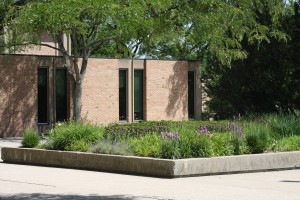 Early this week I posted my report on the 2011 Midwest Composers Symposium, wherein I mentioned the fact I had heard a lot of students’ music in a short amount of time. Well, the 30+ works I wrote about Thursday were just the beginning of my new music marathon because Midwest was immediately followed by last Monday’s student composers’ concert at the University of Michigan. That composers’ forum, the year’s second, was refreshingly brief in contrast to the preceding weekend’s protracted program, yet it contained delicious variety and a few personal debuts by composers I was not familiar with.
Early this week I posted my report on the 2011 Midwest Composers Symposium, wherein I mentioned the fact I had heard a lot of students’ music in a short amount of time. Well, the 30+ works I wrote about Thursday were just the beginning of my new music marathon because Midwest was immediately followed by last Monday’s student composers’ concert at the University of Michigan. That composers’ forum, the year’s second, was refreshingly brief in contrast to the preceding weekend’s protracted program, yet it contained delicious variety and a few personal debuts by composers I was not familiar with.
Monday’s concert began with an electro-acoustic work by Robert Alexander, an accomplished, technologically oriented composer/sound artist who I saw perform with the MiND Ensemble last Spring. Mr. Alexander’s piece, a line between two spaces (turning and turning and resting), featured composer David Biedenbender at the piano and a host of live electronic devices. As I gathered, the work was mainly improvised, though it seemed like the overall structure – mostly in terms of energy level – had been agreed on beforehand. Most remarkable about the piece is the way in which Mr. Alexander’s electronics interacted with the piano. At first, the piano’s sound is undistorted, with the first synthesized sounds regurgitating the piano’s music and then shifting the pitch ever so slightly. However, the electronics increasingly gain power over the piano, achieving a beautiful and stunning summit whereby the electronic part actually subsumes the acoustic space of the piano, and the instrument is no longer audible.
The next two pieces were beautiful songs performed by composers David Wolff (tenor) and Michael Schachter (pianist). First came Mr. Wolff’s “Of Mere Being”, an impressionistic setting of Wallace Stevens. With its impulsive musical moods, “Of Mere Being” reflects the text impeccably and expressively without being obvious. Moreover, Mr, Wolff’s performance, for both songs, was fantastic and demonstrative of his impressive musicianship. Mr. Schachter’s Pierrot (Heart), followed and didn’t shy away from the mantle of excellent vocal writing introduced carried by “Of Mere Being”. Pierrot sets a poem by Langston Hughes, and opens simply to establish a somber, contemplative space from which the narrator will tell his story. Like “Of Mere Being”, Pierrot merges the piano and singer into a single dramatic force that illustrates the text without being to transparent. Particularly important to the drama in Mr. Schachter’s work is the aforementioned simplicity of the opening material. This idea’s expressivity grows slowly, only to explode rather gloriously in the song’s captivating climax.
E. Ross Ura’s En Moto Perpetuo, for two percussionists, followed Pierrot. Admittedly I was a little nervous when the program described Mr. Ura’s “algorithmic” approach to writing the piece, but the music was not weighed down by his process. The work unfolds in very clear sections that progress both in terms of energy level and color, as a wide array of instruments are eventually introduced. With multiple kinds of gongs, cymbals, drums and woodblocks, timbre is a driving force in the work, and both parts contribute equally to the music’s dynamically entertaining soundscape. Simliarly notable for its color was Andrew Kohler’s Passcaglia for Wind Quintet, op. 3, the concert’s penultimate piece. The first third of the piece is restrained to a narrow range as the members of the ensemble enter into the music’s contrapuntal web. It is clear Mr. Kohler has heavily considered timbre when the flute comes in and limits itself to the breathy low end of its register. The oboe’s entrance is the first to liberate the music from mid-range, though the instruments never truly soar. Again, Mr. Kohler tends to focus on the throaty lower ranges of the oboe and flute, even piccolo, as his charming, neo-romantic passacaglia presses on to its conclusion.
Preceding Mr. Kohler’s work was Ron Amchin’s Bells of “The Angelus”, a musical reaction to Jean Francois Millet’s painting “The Angelus”. The piece has a very limits harmonic field, with melodies that are clearly drawn from repeated, vertical sonorities in the style of tintinnabulation. Mr. Amchin harnesses the piano’s resonance by repeating harmonic ideas. This lends the piece a degree of timidity than is stripped away in its booming climactic section. Even then, however, Mr. Amchin creates an echoe – symbolic, in my mind, of bell – by recalling the work’s memorable opening chords. Finally, the concert’s closing number was Corey Smith’s blacklight for string quartet. As fate would have it that night, Corey was forced to fill in for the quartet’s second violinist…on accordion! To me, accordion and strings combine rather fantastically, and I loved this unexpected instrumentation. Essentially, the piece is a fantasy on club dance music nested within dark, dense, brooding harmonies. Although the eclectic sections appear frequently, Mr. Smith is wise to tinker with the beat’s regularity producing a delightful and fun piece that, in my opinion, should always include accordion from now on.
